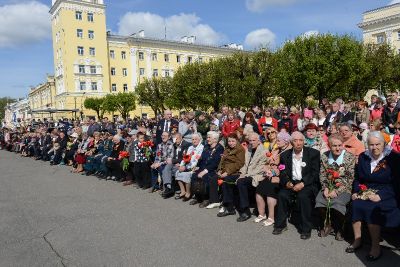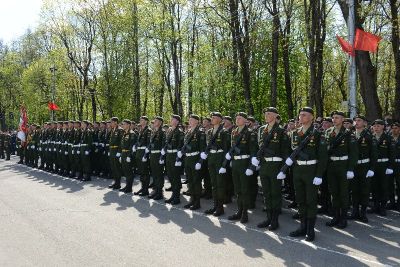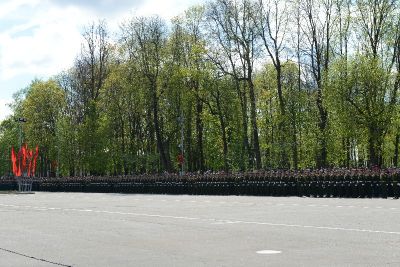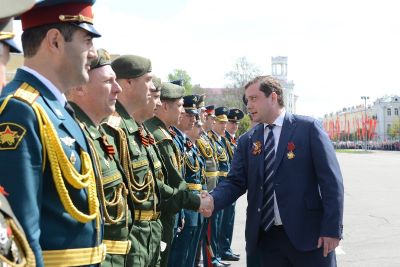The Anniversary of the Great Victory in Smolensk region
The parade of the Smolensk garrison troops, held in the main square of the regional center, gave start to the celebrations of the 70th anniversary of the Great Victory in Smolensk.
More than 1,600 military men and members of the enforcement agencies of the region marched across Lenin Square. The soldiers who risked their lives while the combat missions and young warriors who have yet to continue the heroic chronicle of the Russian Armed Forces stood in columns shoulder to shoulder.
The students of the Air Defense Military Academy of the Russian Federation Armed Forces named after Marshal of the Soviet Union Vasilevsky, railway forces soldiers and a detachment of the troops of the Russian Interior Ministry "Mercury", the employees of the regional department of the Federal Penitentiary Service and the Main Department of the Russian Emergencies Ministry in Smolensk region took part in the parade. The students of the cadet corps named after Field-Marshal Kutuzov and the company of young drummers also participated in the parade.
The parade was greeted by the veterans - former soldiers and officers who liberated Smolensk region and defended Stalingrad, snipers and partisans, members of the medical service, those who survived the blockade, home front workers - all those who made the Victory in the Great Patriotic War closer. Special applauses greeted the soldiers-internationalists and veterans of the combat actions in the North Caucasus.
After the walking column of the Smolensk garrison troops, 19 units of military equipment went across Lenin Square. The residents and guests of the city could see the anti-aircraft missile systems "OSA" and portable anti-aircraft missile systems "Igla-C", anti-aircraft guns Zu-23, the legendary fighting gun ZiS-3 (the model of 1942), the armored car "Tiger", the armored transporter BTR-80, and the armored vehicles Ural-4320.
The Deputy Head of the Smolensk territorial garrison Colonel Boris Novikov was the parade commander, and the Head of the Smolensk garrison, Chief of the Military Academy Colonel Gleb Eremin inspected the parade.
Governor Alexei Ostrovsky congratulated the residents of Smolensk with the long-awaited and touching holiday, before the parade he talked to the veterans here in Lenin Square. Talking to the victorious soldiers, the Head of the region thanked them for their initiative to create a monument to warriors, defenders and liberators of the city, which was opened in Smolensk on May, 8. The Governor also told the veterans about the opening of the Eternal Flame memorial in the heroic Vyazma. Speaking about the social support of the veterans of the Great Patriotic War and persons equated to them, Alexey Ostrovskiy urged the veterans to apply for any required help personally to him.
The most impressive and unforgettable part of the parade in Smolensk was the parade of the participants of the patriotic action "Immortal regiment" marching across Lenin Square for the second consecutive year. The history of the action began in 2012, when residents of Tomsk marched in columns with raised portraits of their nearest and dearest war veterans. A year later, 200 cities of Russia, Belarus and Ukraine joined the "Immortal regiment". At the moment, the geography of the "Regiment" continues to expand - more than 12 countries and 1,000 cities claimed their readiness to participate.
This year, only in Smolensk, about 17 thousands of the Smolensk residents, who cherish the memory of the victorious warriors, marched in the column of the Regiment, which closed the parade. Governor Alexey Ostrovskiy and the Heads of the regional law enforcement agencies also took part in the action. The Head of the region marched in the column of the "Immortal regiment" with a portrait of his great-grandfather - Alexey Yakovlevich Anurov, who did not return from the war.
The action aimed to preserve the memory of those terrible events deeply touched the spectators: neither veterans nor the younger generation could hold back tears.
Among the participants of this year’s "Immortal Regiment" there was, for the first time, a medical battalion, which united the people carrying the portraits of their relatives who were in medical service during the war.




